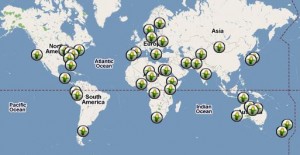What’s going on with mangoes in India? It seems I can’t fire up my feed reader these days without some tale of mango woe popping up. If it’s not Noor Jahan being down to its last four trees, it’s the Kesar variety being cut down in Gujarat. And the Mango Mela — an agricultural fair held in Bangalore — only featured 20 varieties last year, after a really bad, low quality harvest. The latest thing is that Malihabad in Uttar Pradesh has gone from 700 varieties to just a few due to market pressures:
“The reason for certain mango varieties facing extinction threat is the fact that mangoes like Dussheri, Chosa, Lucknowi have taken over the market in a big manner. Mango growers get a good price for these varieties. However, mango varieties that are facing extinction are not able to make their presence felt in the market as there are few trees grown of these varieties,” Haji Kalimullah Khan, a veteran mango cultivator said.
It might be the season, I suppose. There does seem to be a spike of interest in mangoes in March-May. But are things really as bad as all that? Or is the press just focusing on the bad news and ignoring the good, as usual? And if things really are bad, is anything being done about it? Perhaps an expert on Indian mangoes will explain it all to us.
